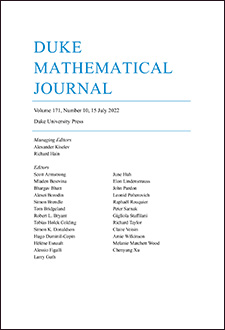Abstract
Let $f$ be a function such that for every $\varepsilon > 0,\ n^{\log n} \leq f(n) \leq n^{\varepsilon n}$ holds if $n$ is sufficiently large. Suppose that $\log f(n) / \log n$ is nondecreasing. Using sequences of finite alternating groups, for every such $f$ we construct a $4$-generator group $\Gamma$ such that $s_n(\Gamma)$, the number of subgroups of index at most $n$ in $\Gamma$, grows like $f(n)$.
This essentially completes the investigation of the ``spectrum'' of possible subgroup growth types and settles several questions posed by Lubotzky, Mann, and Segal.
As a by-product we obtain continuously many nonisomorphic $4$-generator residually finite groups with isomorphic profinite completions.
Our construction also sheds some light on a problem of Grothendieck [Gr]; we obtain an abundance of pairs of finitely generated residually finite groups $\Gamma_0 \lessthan \Gamma$, such that the natural map $\widehat \imath : \widehat\Gamma_0 \to \widehat\Gamma$ between profinite completions is an isomorphism, but $\Gamma_0 \not \cong \Gamma$.
Citation
László Pyber. "Groups of intermediate subgroup growth and a problem of Grothendieck." Duke Math. J. 121 (1) 169 - 188, 15 January 2004. https://doi.org/10.1215/S0012-7094-04-12115-3
Information





